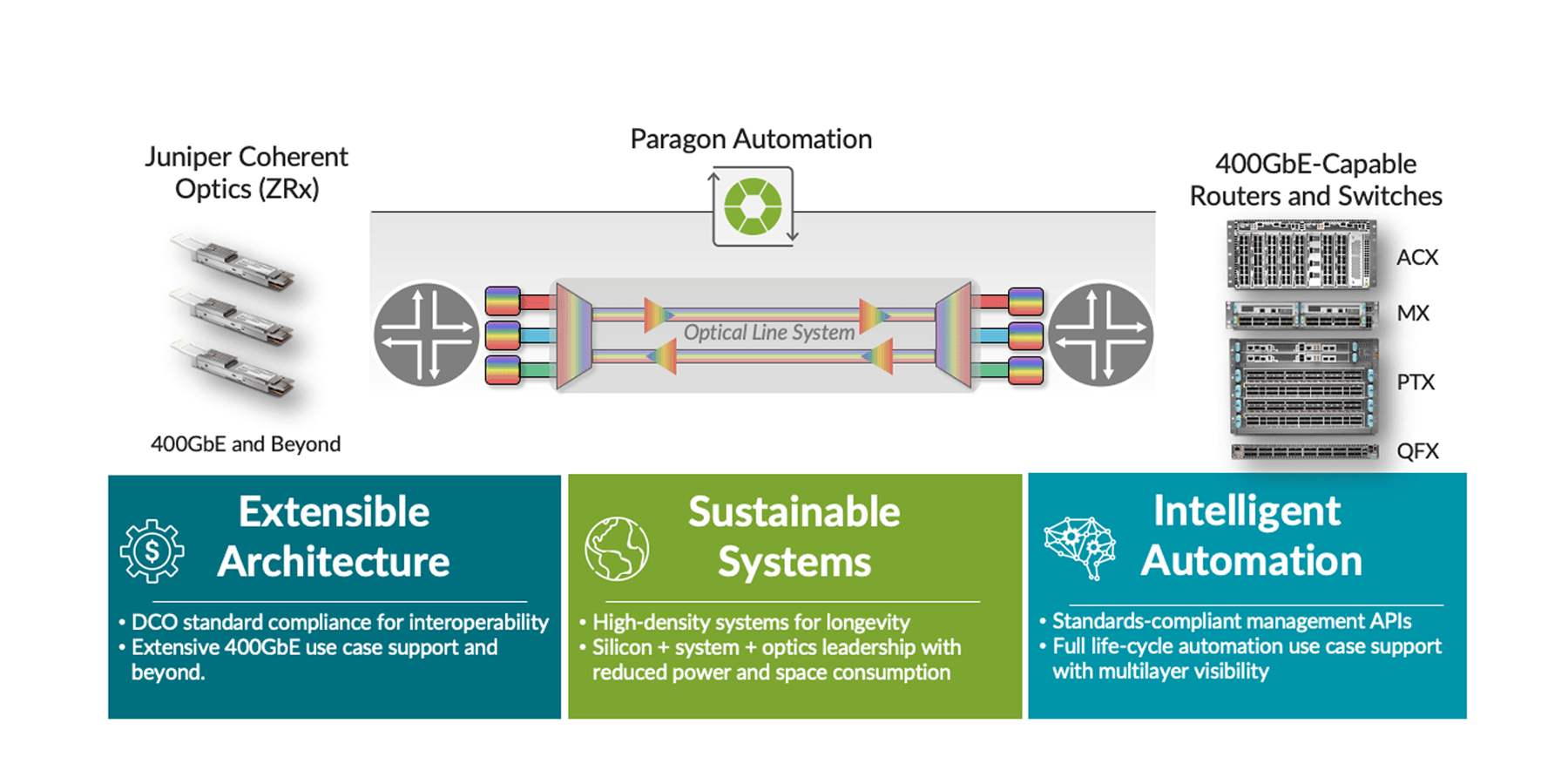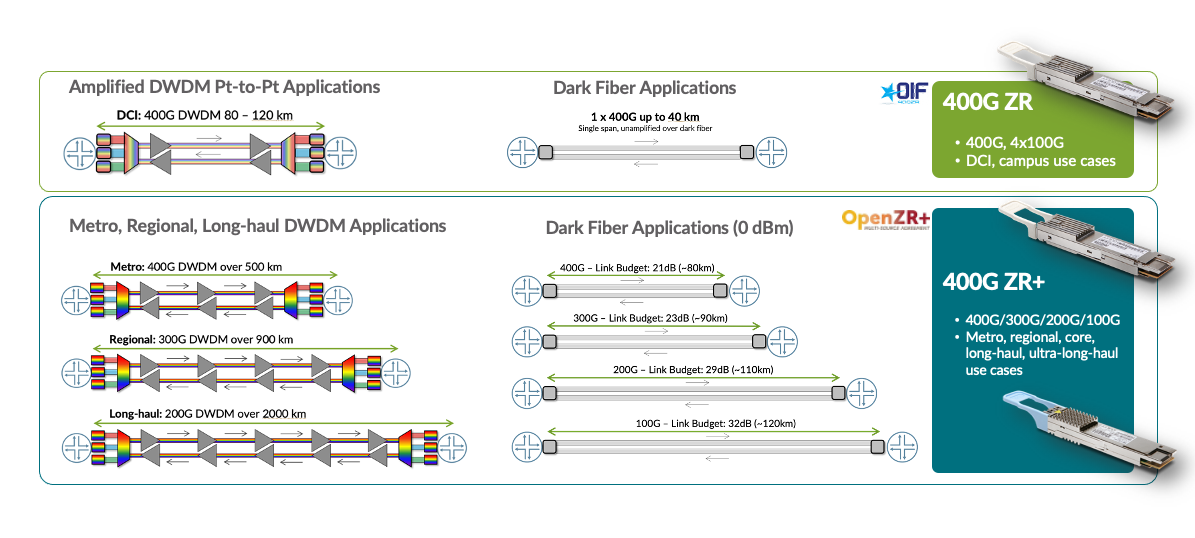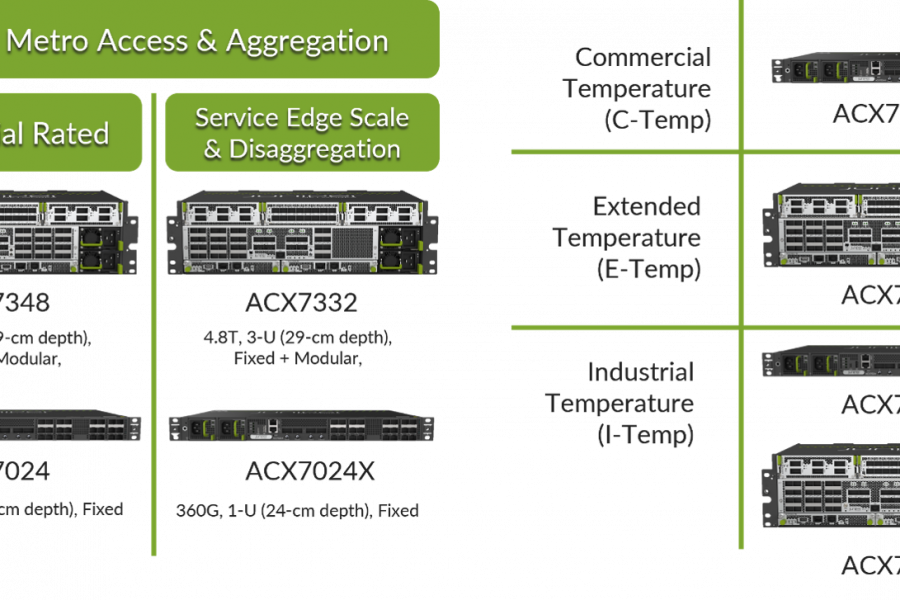Investing in network updates requires incremental improvements. A small reduction in cost-per-bit here, and a marginal efficiency increase there. It’s rare—unheard of, really—that something can radically change the economics of a business. Yet that’s exactly what cloud providers, service providers and enterprises are now contemplating as we enter the age of packet optical convergence.
With the ability to plug next-generation coherent optics directly into IP routers and switches—also called IP over Dense Wavelength Division Multiplexing (IPoDWDM)—a world of new possibilities awaits. Converged IP-Optical links bring 400G capacity and beyond to every corner of metro access and aggregation, edge and core networks. IPoDWDM also supports converged mesh architectures leveraging IP as the control plane to liberate vast reserves of idle lambdas traditionally set aside for optical network protection, instantly freeing up as much as 50% more bandwidth. And it eliminates the need for external DWDM transponders for many applications—slashing power and space requirements, driving down CapEx, simplifying management and reducing Total Cost of Ownership (TCO) by more than 45%.
These are the sets of numbers that transform industries. For those that run large-scale networks, IPoDWDM offers a once-in-a-generation opportunity to reimagine the economics of the business. The only questions are when to start and who’s best positioned to help. The first answer is: now. The second: Juniper Networks.
Today, Juniper unveiled the Converged Optical Routing Architecture (CORA), our comprehensive solution to tap into the IPoDWDM revolution. CORA combines groundbreaking Juniper 400G ZR/ZR+/0-dBm standardized pluggable optics with our industry-leading portfolio of 400G-capable routing and switching platforms, plus simplified multi-layer management with Juniper Paragon® Automation. CORA can help customers unleash unprecedented bandwidth everywhere they need it. And it’s about to change everything we thought we knew about network and service design.
Welcome to the IPoDWDM Revolution
CORA is an extensible IPoDWDM architecture that brings the benefits of IP-optical convergence to the most demanding use cases. CORA combines:
- Extensible architecture: Juniper Coherent Optics (JCO) 400G ZR/ZR+ pluggables open up new network and service design possibilities. With next-generation optics in a standard QSFP-DD form factor, customers can mix and match pluggables to support different reaches and bit rates in the same line card, without sacrificing platform capacity. With CORA, IPoDWDM suddenly becomes a real option for a much wider range of metro, regional and core network use cases.
- Sustainable systems: Juniper’s broad portfolio of 400G-capable routers and switches sets the standard for system capacity and longevity. Juniper ACX Series, MX Series, PTX Series and QFX Series platforms lead the market in silicon and system innovation, driving higher performance in smaller, more power-efficient footprints. And our ongoing optical innovations position customers to take full advantage of 400G transport capacity today, and 800G and beyond in the future.
- Intelligent automation: Juniper’s Paragon Automation Suite can help make the most of IP-optical convergence, while simplifying network operations. Paragon uses the open, standards-compliant management APIs in CORA solutions to automate a variety of lifecycle network operations in multivendor environments, interoperate with third-party management systems and provide multi-layer visibility.

By combining all of these capabilities in a unified solution, CORA gives customers the agility to fast-track new network and service deployments and accelerate time-to-revenue. They can drive down energy consumption and carbon emissions across the network. They can simplify and automate operations across both IP and optical domains. And they can meet the insatiable demand for bandwidth wherever it’s needed, at a much lower cost.
Unleash New Use Cases with CORA
Juniper’s 400G ZR+ pluggables feature more powerful optics and new channelization options to serve any metro, regional or core network with diverse distances and bitrates (Figure 2). JCO400 ZR+ optics, for example, can support metro 400G DWDM links over 500km, regional 300G DWDM links over 900km and long-haul 200G DWDM links over 2,000km. And with new OpenZR+ 0-dBm optics with high transmit power, customers can even deploy coherent pluggables in networks with significant fiber budget losses, including over ROADM infrastructures spanning hundreds of kilometers. Since these are standards-based, reconfigurable optics, they can also be reprogrammed to support new requirements and use cases without forklift overhauls.

CORA’s ability to collapse previously separate network layers and management planes also allows movement from legacy protection schemes to a converged mesh architecture. That’s a huge deal since traditional optical transport networks reserve optical bandwidth with 1:1 protection—meaning up to 50% of the WDM capacity may be idle. By handling protection at the services layer, critical traffic can be protected using a fraction of the bandwidth.
Drive Down Power Consumption and Costs
Next-generation optics are just one part of the IPoDWDM revolution. CORA also draws on the latest ASIC and adaptive power innovations in Juniper routing systems to reduce power consumption and CO2 emissions, even as capacity increases. For example, the latest Juniper ACX, MX and PTX platforms deliver 77%, 71% and 59% power efficiency improvements, respectively, over previous generations.
The biggest sustainability improvements, however, come from eliminating external transponders and the power consumption and carbon footprint that comes with them. Those benefits also affect the bottom line. Recently, Juniper performed an economic analysis to compare a Juniper CORA implementation (a PTX router using Juniper Coherent Optics) versus one using traditional transponders. By eliminating the need to buy and maintain the transponders, the CORA model translated to 55% less power consumption, 75% less rack space and 54% lower carbon emissions than traditional network architecture—and more than 45% lower TCO overall.
Streamline Operations
Traditional siloed operations in IP and optical organizations have been yearning for more efficient, multi-layer and domain-agnostic automation tools that come with the promise of IP over DWDM. Juniper CORA works with Paragon Automation to enable multi-layer visibility and domain-agnostic interfaces in multivendor networks. With Paragon Automation, customers can:
- Actively and passively monitor multi-layer network and service performance.
- Break free from vendor lock-in and use preferred management software, controllers and traffic engineering tools.
- Automate lifecycle operations such as device onboarding assurance, IP-optical resiliency and capacity optimization.
- Preemptively reroute traffic in response to degrading conditions in the underlying optical network, leveraging optical transceiver telemetry before service disruption occurs.
The Juniper Difference
With its unique combination of extensible architecture, sustainable systems and intelligent automation, CORA brings flexible, standards-based IPoDWDM to real-world networks. And it’s no surprise that Juniper is the one delivering it. While other vendors try to keep customers locked into proprietary optical ecosystems, Juniper provides the following:
- Optical standards leadership: Various Juniper employees are multi-term board members in the Optical Internetworking Forum (OIF) and Ethernet Alliance. We are a founding promoter member of the OpenZR+ MSA, QSFP-DD MSA and OSFP MSA, and we participate in other industry groups. We played a central role in defining multiple optical standards, including 400ZR and OpenZR+.
- Commitment to interoperability: Juniper doesn’t just define standards. We conduct rigorous testing to ensure that our IPoDWDM solutions work seamlessly, including an exhaustive CORA validation program with our co-developed and Juniper-branded coherent pluggables across our 400G-capable routing and switching portfolio. We can help customers use best-of-breed innovations across the network and reduce supply chain risk.
- Unified support: Even as we help customers tap into multivendor innovation, we support Juniper and partner technologies as a single solution with unified Juniper technical support. Customers can work with a single vendor, with a single point of contact for the entire solution.
Get Started
Ready to see how converged packet-optical architectures can unleash new possibilities for your network and business? Get more details on how Juniper is leading the revolution in open, standards-based IPoDWDM at the Juniper Converged Optical Routing Architecture solution page.


